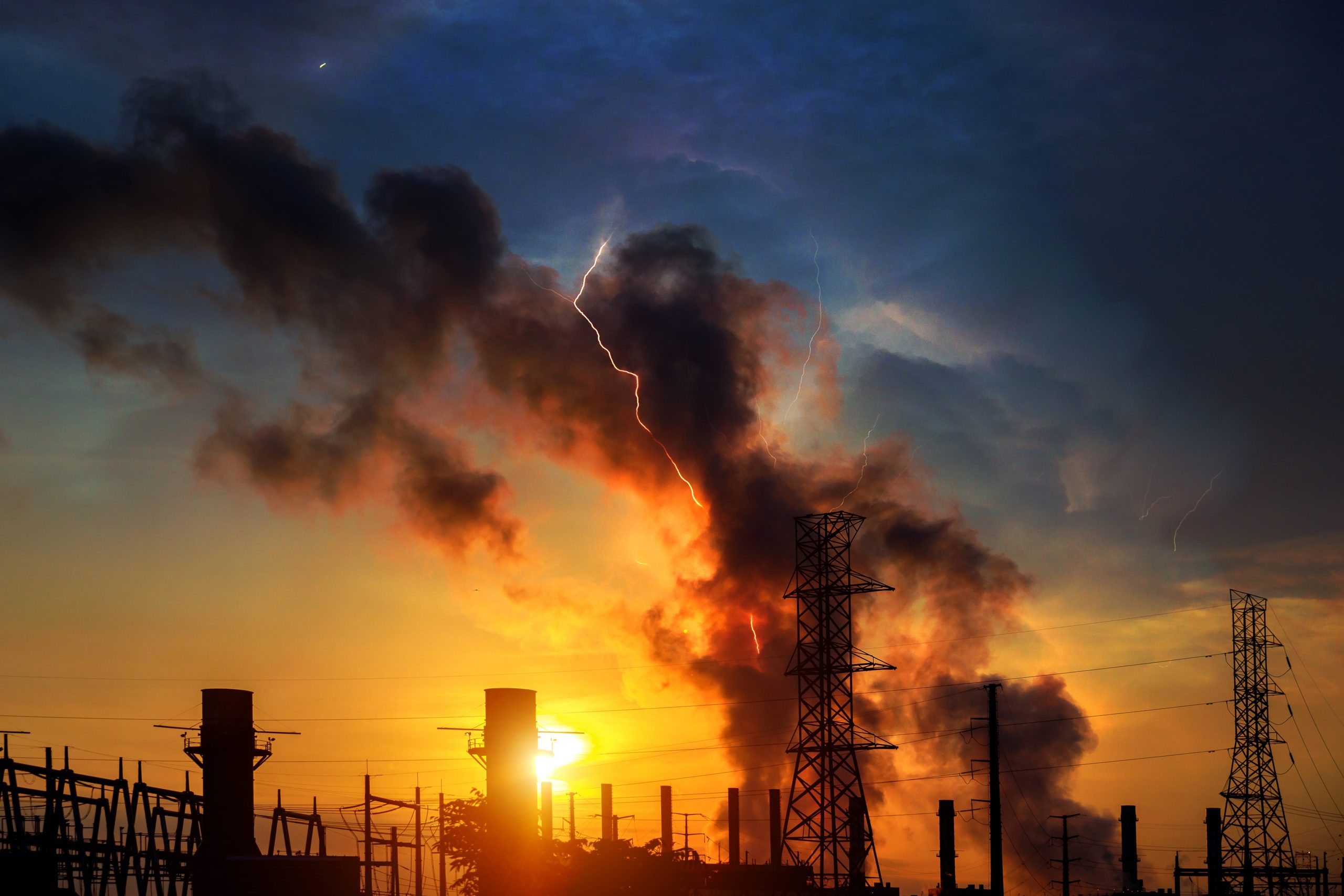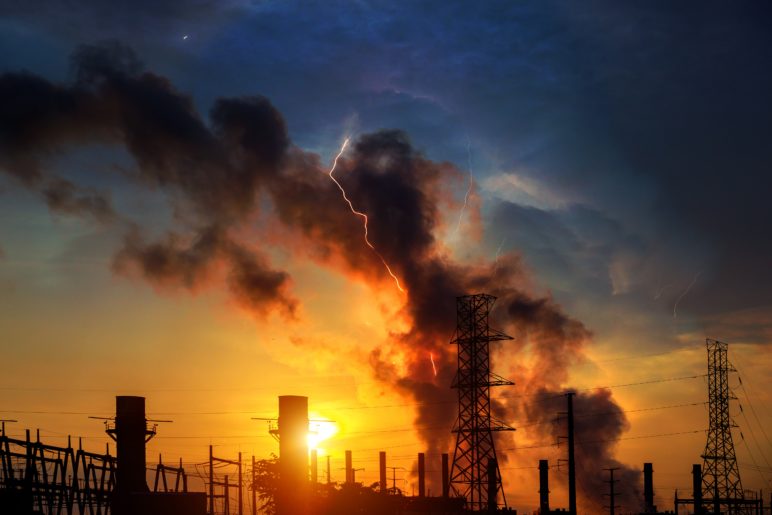Oregon and Washington boast aggressive climate plans that aim to decarbonize the Northwest economy over the next 30 years. Yet these plans face a major roadblock in the form of the privately-owned utilities that supply gas to customers across the region. These utilities have not gotten the memo on decarbonization: they are not planning to reduce their sales of natural gas, but to increase gas consumption over the coming decades. That’s a big problem; decarbonization requires states to move beyond gas.
There is mathematically no way the states can reach their climate targets without sharply curtailing gas.

There is mathematically no way the states can reach their climate targets without sharply curtailing gas. Oregon’s climate laws aim for an 80 percent reduction in carbon by 2050, yet more than one-third of the state’s energy-related emissions come from gas. Meanwhile, Washington is legally obligated to reduce emissions 95 percent below 1990 levels by 2050, but one-quarter of the Evergreen State’s energy-related carbon pollution comes from gas. Simply put, there is no room for compromise.
There is no plan for throttling Northwest natural gas usage
Among the 21 US states with greenhouse gas reduction targets, only five have started formal processes to manage their transition away from natural gas—and none of them are in the Northwest. Lawmakers in Oregon and Washington have mostly focused on cleaning up the power grid and encouraging electrification, but there has been virtually no emphasis at the state level on policy or regulation to guide the industry or consumers as natural gas use declines, as it must. To date, the closest the Northwest states have come to planning for a transition from gas are some public conversations initiated by Oregon’s Global Warming Commission and Washington’s draft state energy strategy, which acknowledges the need for a plan and recommends that the issue be addressed by the state utility commission and the legislature.
Planning for a transition away from gas is important because a laissez-faire approach now will create a crisis later for gas utilities and their customers. As consumers stop using natural gas, fewer ratepayers will make up the “rate base” that provides the revenue utilities need to maintain and operate their expansive distribution pipeline systems. These systems are built to operate for 40 years or longer—which is why decarbonization requires that we stop building more now—with the upfront costs recouped from ratepayers over many decades. But if gas sales decline sharply in line with decarbonization targets then there will be far fewer ratepayers by 2050, which raises a big question about who, exactly, will pay off the costs of the pipelines they built. Under current law, that burden would fall on the remaining (but ever-shrinking) pool of ratepayers who are still gas customers. And, without careful planning, those are likely to be lower-income households and renters, which would mean ever-rising prices for those least able to pay.
Look to New Jersey to move beyond gas? Leading states provide models for Cascadia
If Cascadia wants to decarbonize—and to do it fairly—then state policymakers would do well to pay attention to the advancements already underway in states that are planning: California, New York, Colorado, Massachusetts, and New Jersey. Toward that end, we offer an overview of these states’ leadership with a few key lessons for Cascadia.
California is so far the only state with active policymaking aimed at designing an orderly retirement of the gas delivery system.

CALIFORNIA
The Golden State is leading the way with admirable approach that regulators in Oregon and Washington could adopt swiftly.
California is so far the only state with active policymaking aimed at designing an orderly retirement of the gas delivery system. The effort was initiated by a 2019 report by Gridworks that outlined four basic strategies for California to confront the challenge of declining gas usage:
- Stop building new gas infrastructure;
- Plan deliberate electrification and retirement of sections of the existing gas delivery system;
- Organize an equitable transition for key groups, especially the current gas workforce, low-income households, and other disadvantaged communities;
- Reform unhelpful regulations such as eliminating the obligation for gas utilities to serve any interested customer and adjusting ratemaking formulas to reflect accelerated gas infrastructure retirement.
On the heels of the Gridworks report, California utility regulators opened a docket to examine long-term natural gas policy and planning in light of California’s greenhouse gas emission laws with a focus on these same concepts with decisions scheduled for mid-2022.
Other states are primarily focused on preventing unnecessary and costly expansions of the gas pipeline system.
NEW YORK
New York offers Northwest states a model of utility regulators planning to meet state climate law.
In 2019, New York passed a sweeping climate bill, the Climate Leadership and Community Protection Act, that established emissions reduction targets and mandated emission-free electricity for the state by 2040. Following its passage, the state utility regulator, the New York Public Service Commission, initiated a proceeding to harmonize gas infrastructure planning with the new law. The Commission’s deadline for the new gas planning process was originally August 2020, but has been extended several times, most recently until December 2020. Meanwhile, a group of 175 New York State elected officials have signed on to a letter urging regulators to introduce measurable emission reduction requirements on gas utilities and asking for guidance on policies to replace fossil fuels with electricity in buildings to avoid perpetuating fossil-fuel combustion in buildings.
COLORADO
Oregon and Washington could use utility regulation in an even more assertive way to meet state climate law, as Colorado is doing.
In September 2020, Colorado’s largest gas utility, providing fuel to around 80 percent state, entered into a settlement agreement with the state’s Public Utilities Commission of Colorado, laying the groundwork for the type of gas infrastructure planning already underway in California and New York.
Recognizing that there are cleaner and cheaper electricity-based alternatives to expanding gas pipelines, the Commission ordered the utility to seek pre-approval for any large new project, an important reversal of business-as-usual. Normally, utilities seek regulatory approval for reimbursement of infrastructure investments after making the investment, and regulators seldom put themselves in the position of pre-approving investments. From now on, Colorado regulators will be examining any gas infrastructure investment exceeding $15 million to determine if electrification would serve the public better than pipeline expansion.
What’s more, Colorado’s legislature passed emission reduction requirements in 2019 that could trigger a series of technical but important changes. Regulators will commission a new study of asset depreciation to determine how an impending decline of natural gas use will affect the financial value of the utility. And, the Commission will kick off a new process for planning longer-term investments, those ten to 20 years in the future, with an eye toward meeting state climate goals.
MASSACHUSETTS
In Massachusetts, state agencies are coordinating a strategy to plan for a transition away from gas, another valuable lesson for the Northwest.
Massachusetts is legally committed to reducing greenhouse gas emissions, an effort that has been advanced by Governor Charlie Baker who in 2016 ordered state agencies to better define the pathway to lower emissions. (Governor Inslee has developed a similar decarbonization pathway analysis in Washington.) Then in early 2020, Governor Baker accelerated decarbonization plans for Massachusetts, essentially committing the state to net-zero emissions by 2050. The State’s Attorney General, Maura Healey, followed up by asking gas utility regulators to examine the likely future of plummeting gas use.
The state utility commission then issued an order requiring gas companies to evaluate their plans to reduce emissions to support the State’s decarbonization goals. They have until March 2022 to return their findings and proposals. But meanwhile, at least one large gas utility in Massachusetts, National Grid, has already announced its plan to achieve net-zero greenhouse gas emissions by mid-century.
NEW JERSEY
If Cascadia hurries, it can catch up with New Jersey where leaders are embarking on serious study of gas utilities and gas infrastructure.
In January 2020, Governor Phil Murphy unveiled a roadmap for achieving New Jersey’s decarbonization vision by 2050. The seven-point strategic roadmap calls for utilities to assess their pipeline capacity and plan for a gradual reduction in their use. And it calls for state policymakers to study the various laws and regulations that prop up the industry and support its longevity. While New Jersey has not yet acted on these strategies, the state has taken an important first step by acknowledging a need to plan for the impending reality of declining gas usage.
The path forward for Oregon and Washington
There is no way around it: decarbonization in the Northwest will mean decommissioning large portions of the region’s natural gas system—retiring its physical infrastructure and reordering its financial models. It is entirely possible for Oregon and Washington to do that fairly and inexpensively, but not without planning to move beyond gas now, as other states are doing.
In our next article, we will explore in more depth the pathways to a decarbonize future Northwest. And, we will see how these pathways can shape policy for Cascadia.












Eli Spevak
Great article! Although it didn’t quite pass, OR did almost pass a bill that would create a special rate class for low-income utility customers. This is a critical strategy to ensure that lower income residents don’t get hammered when, as we wean ourselves from the gas industry, gas prices start to spiral up as demand drops and infrastructure/distribution costs stay relatively fixed. I’m hopeful this passes next session, since I think it has bipartisan support. Of course, there’s plenty of other things we can and should be doing in the NW to reduce gas use; this is just one example of our nascent (and way too slow) steps in that direction.
Kris Nelson
Helpful roundup of the diverse efforts to decarbonize the gas system. Another path that several Europiean countries are undertaking is known as power-to-gas, though here gas means hydrogen. To summarize, here’s one example in my recent letter to the NYT: https://www.nytimes.com/2020/10/29/opinion/letters/joe-biden-energy.html As surplus renewable power is “stored” as green hydrogen, it can be injected into the gas grid up to 20 percent of the methane content. In fact, BC has already set initial regulations for ramping up these amounts. The letter notes the example of converting a coal/gas plant in UT to operate eventually on renewable hydrogen.
Other renewable gaseous news is here from the Renewable Hydrogen Alliance, an industry group based in Portland: https://mailchi.mp/8685ec19aaf9/rha-october-newsletter.
Another example is at UC Irvine, where an electrolyzer produces hydrogen to inject into the campus’ gas grid.
In Oregon, RHA has proposed landmark legislation to enable utilities to recover investments in hydrogen production from their renewable portfolios to achieve 100 percent renewables by 2030. While it may be removed from their website, a summary of the legislative concept is here: https://renewableh2.org/our-esa/
Another policy element deemed critical to supporting renewable hydrogen production among utilities is use of interruptible tariffs. Tacoma Power, in its recognition of their incentive value, has already enabled one:
Tacoma Public Utilities Passes Interruptible Tariff
Members of the Renewable Hydrogen Alliance have identified establishing discounted interruptible electric power tariffs as a top priority for the organization. On October 28, the Tacoma (Washington) Public Utility Board approved Tacoma Power’s proposed “Electrofuel Service Pilot” (Schedule EF). The proposed pilot tariff offers a discounted energy rate ($0.033147/kWh) and demand rate ($5.72/kW-month) plus monthly administrative charge ($7,445) to provide guaranteed service on 85% of all hours of the year along with the utility’s option to interrupt on 15% of hours with ten minutes’ notice. The pilot tariff covers up to 65 MW of interruptible demand, and will go into effect on April 1, 2021 subject to approval by the Tacoma City Council.
Keep up the outstanding work!
Kris Nelson
Chair, Oregon Policy Subcommittee
Renewable Hydrogen Alliance
ALBERT LEPAGE
Hello . . . First, know that I agree with what you wrote . . . however, when push comes to shove from the natural gas companies . . . this is the kind of information they are putting out that will need to be addressed when lobbying legislators or elected government officials . . . as found on this website of the NW Gas Association https://www.nwga.org/category/news/ . So start crafting your messages and testimony to proactively address what they are saying about how great gas is . . . Respectfully and with an intent to successfully and effectively meet their arguments and decrease natural gas usage.